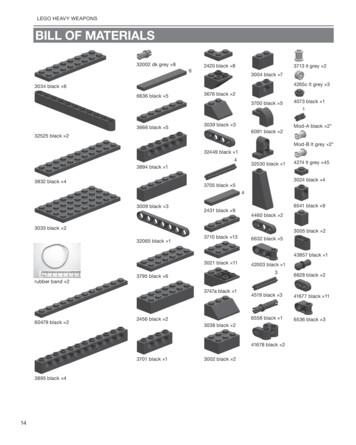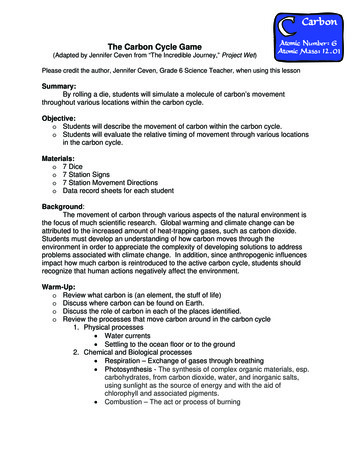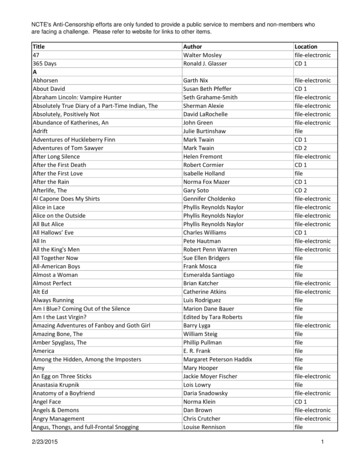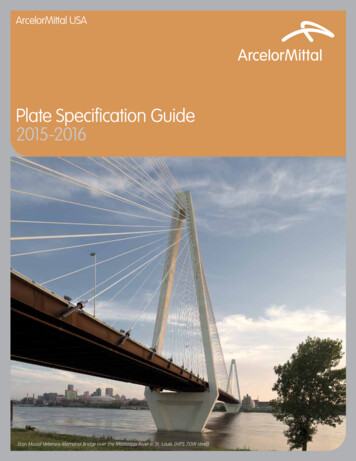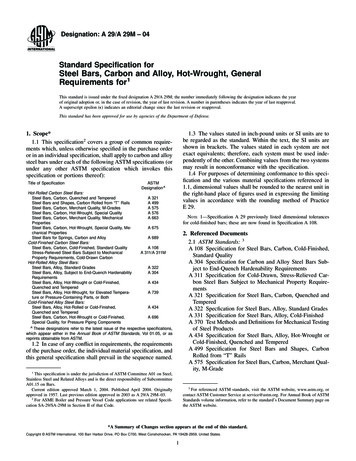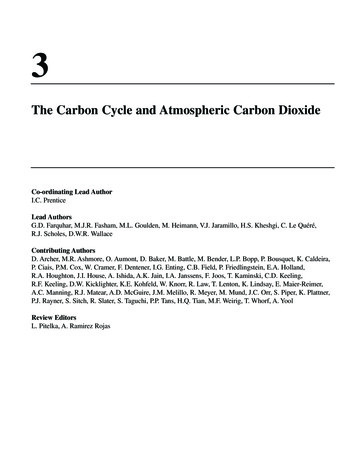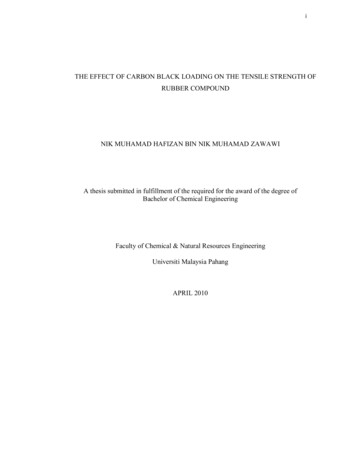
Transcription
iTHE EFFECT OF CARBON BLACK LOADING ON THE TENSILE STRENGTH OFRUBBER COMPOUNDNIK MUHAMAD HAFIZAN BIN NIK MUHAMAD ZAWAWIA thesis submitted in fulfillment of the required for the award of the degree ofBachelor of Chemical EngineeringFaculty of Chemical & Natural Resources EngineeringUniversiti Malaysia PahangAPRIL 2010
vABSTRACTThe purpose of this study is the effect of carbon black loading on mechanicalproperties of rubber compound. There are several studies about tensile strength ofrubber compound and the results are positive. Rubber blends are used for manyreasons such as lowering the compound cost, for ease of fabrication and to improvethe performance of the rubber industrial. Study the effect of tensile strength onrubber compound based on filler loading has played important role in contributingthe fundamental to formulate the rubber compound and investigate the mechanicaleffect. The aim of this study is the effect carbon black loading on tensile strength ofrubber compound. The previous study was show that the different filler and loadinggive the different effect reinforcing to rubber compound. The objective in this studyis to study the effect of filler loading on the tensile strength of rubber compound. Weare using two roll mills in high temperature and at medium speed this is to ensure therubber mix well with other ingredients. The filler use is carbon black N220 and betested in three experiment based on filler loading at 10phr, 30phr and 50phr. Themechanical properties – such as tensile strength properties of the present industrialrubber – were studied. The study also indicated that filler materials affect on themechanical properties of the blends.
viABSTRAKTujuan kajian ini adalah mengenai kesan campuran karbon hitam pada cirriciri makanikal getah. Sudah banyak kajian megenai “tensile strength” getah dankeputusannya adalah positif. Campuran getah digunakan atas banyak sebab sepertimerendah harga sebatian, untuk pembuatan dan meningkatkan kualiti dalam industrigetah. Kajian kesan “tensile strength” pada getah adalah berdasarkan pada campurankarbon hitam yang telah memainkan banyak perana dalam meyumbangkan kepadaasas pembentukan formula getah dan mengkaji kesan mekanikal. Kajian lepas adamenunujukkan perbezaan campuran carbon black akan menghasilkan kekuatan yangberbeza. Objektif kajian ini adalah untuk mengkaji kesan campuran karbon hitampada “tensile strength” sebatian getah. Kami mengunakan Two Roll Mill mesin padasuhu yang tinggi dan halaju yang sederhana ini untuk memastikan getah bercampurdengan bahan-bahan yang lain. Karbon hitam yang digunakan adalah N220 dan iadijalankan dengan 3 ujian berdasarkan bahagian campuran karbon hitam 10phr,30phr dan 50phr. Cirri-ciri mekanikal – seperti cirri-ciri “tensile strength” getahindustri sekarang – telah dikaji. Kajian juga membincangkan kesan “filler material”pada cirri-ciri mekanikal campuran getah.
viiTABLE OF iACKNOWLEDGEMENTSivABSTRACTvABSTRAKviTABLE OF CONTENTSviiLIST OF ABBREVIATIONSxLIST OF FIGURESxiLIST OF TABLESxiiINTRODUCTION1.1 Background of the Study11.2 Problem Statement31.3 Objectives31.4 Scope of the Study3
viii1.5 Rationale and Significance24LITERATURE REVIEW2.1 Introduction52.2 Natural rubber72.3 Filler92.3.1 Filler properties102.3.1.1 Particles size122.3.1.2 Surface area142.3.1.3 Structure152.3.2 Filler effect162.4 Rubber filler interaction172.5 The mechanical properties of rubber filled172.5.1 Hardness/flexural strength182.5.2 Impact strength182.5.3 Tear strength192.5.4 Resilience192.5.5 Abrasion resistance20
ix2.5.6 Modulus/tensile strength2.6 Equipment (Two Roll Mill)3423METHODOLOGY3.1 Material and formulation253.2 Experiment procedure26RESULT AND DISCCUSSION4.1 Result4.1.1 The mechanical properties4.2 Discussion521272730CONCLUSION AND RECOMMENDATION5.1 Conclusion325.2 Recommendation32REFERRENCES33
xLIST OF ABBREVIATIONSPHR (phr)-part per hundredCBS-N-(1, rbon BlackSMR-Natural RubberIPPD-Iso Propyl-N-P- Phenyllenediamine
xiLIST OF FIGURESFIGURE NO.TITLEPAGE2.3.1Filler-Carbon black N220102.3.1.1.1Filler classification chart2.5.6.1Filler cross linking232.6.1Two roll mill machine244.1.1Force (kN) versus displacement (mm) for 10phr284.1.2Force (kN) versus displacement (mm) for 30phr284.1.3Force (kN) versus displacement (mm) for 50phr294.1.4Part per hundred rubber filler versus tensilestrength2913
xiiLIST OF TABLESTABLE NO.TITLEPAGE2.1.1Generalized rubber formula62.1.2Table of rubber formula25
CHAPTER 1INTRODUCTION1.1Background of StudyThe present day about three quarter of rubber in production is a syntheticproduct made from crude oil. There are about 20 grades of synthetic rubber and theintended end use determines selection.In general, to make synthetic rubber,byproducts of petroleum refining called butadiene and styrene are combined in areactor containing soaps suds. Close to 21million tons of rubber produced in 2005 ofwhich around 42% as natural.Today the main sources of natural rubber areIndonesia, Malaysia and Thailand together account around 72% of all natural rubberproduction.The natural rubber is an elastomer that was originally derived from milkylatex, found in sap of some plant. The purified form of rubber is the chemicalpolyisoprene, which can also be produced synthetically. Natural rubber is usedextensively in many applications and products as in synthetic rubber. Natural rubberis an elastomer and a thermoplastic. But we should note that as the rubber isvulcanized into a thermoset. Most rubber in everyday use is vulcanized to a pointwhere it shares properties of both. If it is heated and cooled, it is degraded but notdestroyed.
2At a particular shear rate, shear viscosity increases with blend ratio. Thedependence of flow behavior on extrusion velocity indicates a surface effect. Theextrudate die swell and maximum recoverable deformation are related by a linearrelationship, which is independent of sulfur or accelerator ratio, extrusiontemperature and shear rates blend ratio. The principal normal stress differenceincreases nonlinearly with shear stress. Although natural rubber (NR) is known toexhibit numerous outstanding properties, reinforcing fillers are necessarily addedinto NR in most cases in order to gain the appropriate properties for specificapplications. A wide variety of particulate fillers are used in the rubber industry forvarious purposes, of which the most important are reinforcement, reduction inmaterial costs and improvements in processing. Reinforcement is primarily theenhancement of strength and strength-related properties, abrasion resistance,hardness and modulus. In most applications, carbon black (CB) and silica have beenused as the main reinforcing fillers that increase the usefulness of rubbers. When CBis compounded with rubbers, tensile strength, tear strength, modulus and abrasionresistance are increased. For this reason, CB has been extensively exploited innumerous rubber engineering products. In general, a CB-reinforced rubber has ahigher modulus than a silica-reinforced one.
31.2Problem StatementThe rubber prize is randomly high and low this crisis happens because of thedecreasing rubber supply and the sources are unevenly spread. Rubber price isincreasing and decreasing dramatically every year and it will burden people.Producing rubber compound randomly will increase the quantity and low quality.Also many rubber compounds are wasted.Rubber is durable and safe. The tire industry is the biggest user of rubber,synthetic or natural. But, rubber cannot be destroyed easily and cannot be burneddue to toxic gases it emits while burning. Rubber recycle is the only solution to theproblem. Most of this recycled rubber goes into the production of rubber granuleswhich can be used as mulch for a wide range of operation.1.3Objectivesi.To study the effect filler loading on rheological properties of rubbercompound.1.4Scope of StudyTo achieve the objectives, scopes have been indentified in this research. Thescopes of this research are listed as below:-
4i.Carbon black fillers are used in the rubber compound formulations.ii.Loading of fillers will be varied from 10phr, 30phr and 50phr.iii.The effect on mechanical properties of black-filled compounds will bedetermined.1.5Rationale and SignificanceThis study has potential in minimizing economical losses by study thetensile strength and properties of rubber, aiding analysis on proposed change infiller or carbon black loading by predicting the results. The data and result wegained from this study approximate will decrease the rubber blend cost andincreases the optimum value of tensile strength.
5CHAPTER 2LITERATURE REVIEW2.1IntroductionA literature review is a body of text that aims to review the critical point ofcurrent knowledge and or methodological approaches on a particular topic.Literature reviews are secondary sources, and as such, do not report any new ororiginal experimental work. Most often associated with academic-oriented literaturereview usually precedes a research proposal and result section. Its ultimate goal is tobring the reader up to date with current literature review on topic and forms the basisfor another goal, such as future research that may needed in the area. A wellstructured review is characterized by a logical flow of idea and relevant referenceswith consistent, appropriate referencing style proper use terminology and anunbiased and comprehensive view of the previous research on the topic.Tensile strength is indicated by the maxima of a stress-strain curve and, ingeneral, indicates when necking will occur. As it is an intensive property, its valuedoes not depend on the size of the test specimen. It is, however, dependent on the
6preparation of the specimen and the temperature of the test environment andmaterial. Tensile strength, along with elastic modulus and corrosion resistance, is animportant parameter of engineering materials used in structures and mechanicaldevices. It is specified for materials such as alloys, composite materials, ceramics,plastics and wood.Reinforcement concerns finished rubber part that means vulcanizedmaterial; it is quite remarkable that properties of rubber compounds begin tosignificantly differ from those of unfilled material when the filler has reinforcingcapabilities. In addition to usual hydrodynamics effects, reinforcing filler impartindeed other modification in flow properties whose origin is assigned to stronginteraction arising between and the filler particle. The natural rubber orelastomers would be impossible without the reinforcing of certain filler, such ascarbon black. Reinforcement is usually defined as the “improvement in abrasion,tear, cutting and rupture resistance, in stiffness and hardness of vulcanizedcompounds through the incorporation of finely divided particle.Table 3.1: Generalized rubber formulaMaterial Part per WeightRaw ngFiller50To modified the mechanical propertiesand reduced costSoftener5To ease the processing, to modify thespecific properties.Anti oxidant1To protect the rubber from aging( an
7irreversiblechangeinmaterialproperties after expose to environmentAccelerator1To increase vulcanization process andreduce the time of vulcanizationZinc oxide5As activator to increase the acceleratorefficiencyStearic acid1As activator to increase the acceleratorefficiencySulphur2To produced a cross linkingEach ingredient has a specific function, either in processing, vulcanization orend use of the product. The various ingredients may be classified according to theirspecifics function in the following groups: Filler (carbon black, whiting and chinaclay filler), plasticizer or softeners (extenders, processing aid, special plasticizer),age resistors or antidegradants (antioxidants, antiozonants, special age resistors,protective waxes), vulcanizing or curing ingredients (vulcanizing agents, accelerator,activators), special-purpose ingredients (coloring pigments, blowing agents, flameretardants, odorants, antistatic agent, retarders, peptizers).2.2Natural RubberThe natural rubber Natural rubber is an elastomer (an elastic hydrocarbonpolymer) that was originally derived from a milky colloidal suspension, or latex,found in the sap of some plants. The purified form of natural rubber is the chemical
8polyisoprene, which can also be produced synthetically. Natural rubber is usedextensively in many applications and products, as is synthetic rubber. Rubberexhibits unique physical and chemical properties. Rubber's stress-strain behaviorexhibits the Mullins effect, the Payne effect, and is often modeled as hyperelastic.Rubber strain crystallizes. Owing to the presence of a double bond in each repeatunit, natural rubber is sensitive to ozone cracking. Latex is a natural polymer ofisoprene (most often cis-1,4-polyisoprene) - with a molecular weight of 100,000 to1,000,000. Typically, a small percent (up to 5% of dry mass) of other materials, suchas proteins, fatty acids, resins and inorganic materials (salts) are found in naturalrubber. Polyisoprene is also created synthetically, producing what is sometimesreferred to as "synthetic natural rubber". Some natural rubber sources called guttapercha are composed of trans-1,4-polyisoprene, a structural isomer which hassimilar, but not identical, properties. Natural rubber is an elastomer and athermoplastic. However, it should be noted that as the rubber is vulcanized, it willturn into a thermoset. Most rubber in everyday use is vulcanized to a point where itshares properties of both; i.e., if it is heated and cooled, it is degraded but notdestroyed. The use of rubber is widespread, ranging from household to industrialproducts, entering the production stream at the intermediate stage or as finalproducts. Tires and tubes are the largest consumers of rubber. The remaining 44%are taken up by the general rubber goods (GRG) sector, which includes all productsexcept tires and tubes (Hobhouse, 2005).
92.3FillersFiller are compounding ingredients, usually in powder form, added to cruderubber in relatively large proportions (typically 50 phr). They include two majorgroups, carbon blacks and non-carbon black filler. Carbon black consists mainly offinely divided carbon manufactured by incomplete combustion of natural gas orpetroleum using different process. The non-black filler include whiting and chinaclay. Clay is also used as a semi-reinforcing agent for rubber, and about 900 millionpounds is used per year in the U.S. Most is hard clay mined in Georgia and SouthCarolina. It is used in tire carcasses, sidewalls, and bead insulation. Clay offers somereinforcement to the rubber compound but less than reinforcing grades of carbonblack. Ground and precipitated calcium carbonate is used in rubber compounds. Theground products are added as extender fillers, while the precipitated types offersome reinforcement due to their small particle size. It is reported that over onebillion pounds of calcium carbonate is used in rubber compounds in the U.S. peryear filler are added for economic or technical purpose. Some are incorporatedprimarily to extend and therefore make the final product less expensive and othersmainly to reinforce it. By reinforcement is meant enhancement of properties such astensile strength, tear, and abrasion resistance. Consequently, filler may be classifiedinto two broad groups: reinforcing and non-reinforcing, or active and inactive.However, the distinction between the two groups is not clear-cut because manyfillers exhibit intermediate properties. A rubber compound contains, on average, lessthan 5 lbs of chemical additives per 100 lbs of elastomer. Filler loading is typically10 to 15 times higher. Of the ingredients used to modify the properties of rubberproducts, the filler plays a dominant role. The term ‘filler’ is misleading, implying,as it does, a material intended primarily to occupy space and act as a cheap diluents
10of more costly elastomer. Most of the rubber filler used today offer some functionalbenefit that contributes to the process ability or utility of rubber product. Styrenebutadiene rubber, for example, currently the highest volume elastomer, has virtuallyno commercial use as an unfilled compound (Meyer, 1991).Figure 2.3.1 Filler-carbon black N2202.3.1Filler PropertiesThe characteristics which determine the properties filler will impact to arubber compound are particle size, surface, structure, and surface activity. For manyindustrial applications, like anti-vibrating structures, natural rubber is reinforced bycarbon black. This leads to an increase of the mechanical properties, i.e. elasticmodulus and tensile Strength, as well as a sharp increase of the hysteresis(Chayanoot Sangwichien, 2008). This reinforcement effect comes from the filler–
11filler and filler–rubber interactions, both chemical and physical, which take place atdifferent length scales due to the specific structure of carbon black. Carbon blackparticles are strongly bonded to other elementary particles (10 up to 100) to form anaggregate, the size of which is of the order of 100 nm (Chayanoot Sangwichien,2008). Due to the branched structure of the aggregate, part of the rubber is trappedinside the aggregate and is shielded from macroscopic deformation; the occludedrubber forms with carbon black particles the core of the aggregates and its maincontribution is to lead to an effective filler volume fraction. It is commonly acceptedthat the occluded rubber proportion can be measured from dibutyl-phtalate (DBP)absorption (Chiang Mai Je, 2008). Due to the filler–rubber interactions, polymerchains are strongly linked on carbon black surface and a layer of rubber withmodified. Properties, also called bound rubber, surround the filler particles (J. S.Dick, 2002) a new approach has been recently proposed, that takes into account aglass transition gradient around the inorganic particles. This gradient yields a spatialvariation of the elastic modulus in the vicinity of the particles which can stronglyincrease the modulus of the matrix. The aggregates tend to agglomerate, and at highconcentrations, can form a percolating three-dimensional network. When thedistance between aggregates is low (Jareerat Ruamcharoen, 1990) Carbon blacktypes depend mainly on their specific surface, which is the ratio of the total outersurface of the filler over its mass, their structure and their surface activity and thereinforcement effect is greatly affected by these parameters. The reinforcementeffect is classically split into different contributions: the hydrodynamical effect,which corresponds to the reinforcement obtained by inclusions dispersed within amatrix, the strong interactions between the polymer and the filler, leading to themodified rubber layer and the agglomerate structure contribution, above apercolating threshold. Different models have been proposed to predict, mainly fromthe filler volume fraction, the elastic properties of the composite. Recently,
12micromechanical model developed within a self-consistent approach have shown agood correlation with experimental results. Rubber without filler has very lowphysical strength and no practical use (Edwards, 1990). In three successive steps, fora silica reinforced SBR matrix, in order to highlight occluded rubber and boundrubber interactions, then filler interactions with the previous media, leading to anaggregate and finally bulk rubber with the aggregate. Such approaches have alsobeen extended to the non-linear field, in the case of carbon black reinforced naturalrubber its ability to enhance the strength of rubber vulcanized (Baker ,1978; Bagghi,1981). Numerous studies have been found to be carried out on the addition of carbonblack in the rubber compounds as its ability to enhance the mechanical properties(Medalia, 1978). However, there were still not much works on the effect of carbonblack grades in the tire tread compound apart from the limited number of the works(Patel, 1980).2.3.1.1 Particle SizeIf the size of filler particles greatly exceeds the polymer inter-chain distance,it introduces an area of localized stress. This can contribute to elastomer chainrupture on flexing or stretching. Filler with particles size greater than 10,000 nm aretherefore generally avoided because they can reduce performance rather thanreinforce or extend. Fillers with particles size between 1,000 and 10,000 nm are usedprimarily as diluent and usually have no significant affect, positive or negative, onrubber properties. Semi-reinforcing filler, which range from 100 to 1,000 nm,
13improve strength and modulus properties, the truly reinforcing fillers, which range10 to 100nm significantly, improve rubber properties. Of the approximately 2.1million tons of filler used in rubber each year, 70% is carbon black, 15% is kaolinclay or china clay, 8% is calcium carbonate or whiting, 4% is the precipitated silicasand silicates and the balance is variety of miscellaneous minerals(D. T. Norman,1978). Figure 2.2.1.1 classifies the various filler by particles size and consequentreinforcement potentialFigure 2.3.1.1.1 Filler Classification ChartMost tales and dry –ground calcium carbonates are degrading filler becauseof their large particles size; althouglh the plannar shape of the tale particles
14contributes some improvement in reinforcement potential. The soft clays would fallinto a class of diluents fillers that do not contribute reinforcement, yet are not largethat they degrade properties (D. T. Norman, 1978). The hard clays contribute somereinforcement to rubber compounds, primarily because of their smaller particle sizeand are normally classified as the semi-reinforcing class. The carbon black isavailable in various particles sizes that range from semi-reinforcing to highlyreinforcing. They generally exist as structural agglomerates or aggregates rather thanindividual spherical particles.2.3.1.2 Surface AreaParticle size is generally the inverse surface area. Filler must make intimatecontact with elastomer chains if it is going to contribute to reinforcement. Filler thathave high surface area have more contact area available, and therefore have a higherpotential to reinforce the rubber chains. The shape of the particle is also important.Particles with a planar shape have more surfaces available for contacting the rubberthan spherical particles with an equivalent average particle diameter. Clays haveplanar-shaped particles that align with the rubber chains during mixing andprocessing, and thus contribute more reinforcement than a spherical-shape calciumcarbonate particle of similar average particle size (S. J. Chen, 1998). Particles ofcarbon black or precipitated silica are generally spherical, but their aggregates areanisometric and are considerable smaller that the particles of clay. They thus have
15more surfaces per unit weight available to make contact with the polymer. Rubbergrade carbon black varies from 6 to 259 m2/g.2.3.1.3 StructureThe shape of an individual particle of reinforcing filler like carbon black is ofless importance than the filler’s effective shape once dispersed in elastomer. Theblack used for reinforcement have generally round primary particles but function asanisometric acicular aggregates. These aggregate properties-shapes, density, sizedefine their structure. High structure filler has aggregates favoring high particlecount, with those particles joined in chain like cluster from which random branchingof additional particle may occur. In simplest term, the more an aggregate deviatesfrom solid spherical shape and the larger its size, the higher is its structure. Thehigher its structure, in turn, the greater it’s reinforcing potential (ChayanootSangwichien, 2008).For reinforcing, fillers which exist as aggregates rather than discreetparticles, carbon black in particular, a certain amount of structure that existed atmanufacture is lost after compounding. The shear forces encountered in rubbermilling will break down the weaker aggregates and agglomerates of aggregates(Chayanoot Sangwichien, 2008). The structure that exist in the rubber compound,the persistent structure, is what affects process ability and properties
162.3.2Filler EffectsThe principal characteristics of rubber fillers-particle size, surface area,structure, and surface activity-are interdependent in improving rubber properties.In considering fillers of adequately small particles size reinforcement potential canbe qualitatively small particles size, reinforcement potential can be qualitativelyconsidered as the product of surface area, surface activity, and persistent structureor anisometry (planar or acicular nature). The general influence of each of thesethree filler characteristics above on rubber properties can be summarized asfollows:Increasing surface area or decreasing particle size gives lower resilience andhigher Mooney Viscosity, tensile strength, abrasion resistance, tear resistance, andhysteresis. Increasing surface activity including surface treatment gives higherabrasion resistance, chemical adsorption or reaction, modulus (at elongation 300%),and hysteresis.Increasing persistent structure/anisometry gives higher Mooney Viscosity, modulus(at elongation 300%), and hysteresis, lower extrusion shrinkage, tear resistance, andresilience, and longer incorporation tim
the fundamental to formulate the rubber compound and investigate the mechanical effect. The aim of this study is the effect carbon black loading on tensile strength of rubber compound. The previous study was show that the different filler and loading give the different effect reinforcing to rubber compound. The objective in this study

